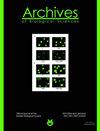Altered arginine metabolism in colon cancer: A sign of increased proliferative potential of tumor-adjacent tissue
IF 0.8
4区 生物学
Q4 BIOLOGY
引用次数: 0
Abstract
Colorectal cancer (CRC) is one of the most frequent forms of malignant tumors in the human population. The literature data about the role of arginine metabolism in CRC point out its double-faced role. In three tissue specimens of 50 patients who underwent surgical resection for colon adenocarcinoma (tumor, adjacent and healthy tissues more than 10 cm from the tumor border - at the incision margin) taken during surgery, polyamines and the concentration of NO2+NO3 and arginase activity were determined. Polyamine levels and arginase activity were significantly increased in cancer and adjacent tissue specimens compared to healthy ones, while the level of NO2+NO3 was significantly lower in cancer compared to both adjacent and healthy tissues. The high polyamine content in the adjacent colonic mucosa indicates a high proliferative potential of tumor-adjacent tissue. Although we found individual correlations indicating the possible prognostic value of arginase, the performed statistical analysis did not show a predictive significance of arginase activity in the examined tissue specimens for five-year survival of the patients. Nevertheless, the obtained results provide the rationale for further studies of arginine metabolism in tissue specimens after surgery in patients with CRC, which could be useful in the evaluation of the risk for tumor growth, recurrence, metastases and survival after surgical intervention.结肠癌中精氨酸代谢的改变:肿瘤邻近组织增殖潜力增加的标志
结直肠癌(CRC)是人类最常见的恶性肿瘤之一。有关精氨酸代谢在结直肠癌中的作用的文献资料指出了它的双重作用。对50例结肠腺癌手术切除患者(肿瘤、离肿瘤边界10 cm以上的邻近组织和健康组织-切口边缘)术中取的3个组织标本,测定多胺、NO2+NO3浓度和精氨酸酶活性。癌组织和癌旁组织中多胺水平和精氨酸酶活性显著高于健康组织,NO2+NO3水平显著低于健康组织。邻近结肠黏膜的高多胺含量表明肿瘤邻近组织具有高增殖潜力。虽然我们发现个体相关性表明精氨酸酶可能的预后价值,但进行的统计分析并未显示精氨酸酶活性在检查组织标本中对患者5年生存率的预测意义。尽管如此,本研究结果为进一步研究结直肠癌患者术后组织标本中的精氨酸代谢提供了理论依据,有助于评估手术干预后肿瘤生长、复发、转移和生存的风险。
本文章由计算机程序翻译,如有差异,请以英文原文为准。
求助全文
约1分钟内获得全文
求助全文
来源期刊
CiteScore
1.40
自引率
0.00%
发文量
25
审稿时长
3-8 weeks
期刊介绍:
The Archives of Biological Sciences is a multidisciplinary journal that covers original research in a wide range of subjects in life science, including biology, ecology, human biology and biomedical research.
The Archives of Biological Sciences features articles in genetics, botany and zoology (including higher and lower terrestrial and aquatic plants and animals, prokaryote biology, algology, mycology, entomology, etc.); biological systematics; evolution; biochemistry, molecular and cell biology, including all aspects of normal cell functioning, from embryonic to differentiated tissues and in different pathological states; physiology, including chronobiology, thermal biology, cryobiology; radiobiology; neurobiology; immunology, including human immunology; human biology, including the biological basis of specific human pathologies and disease management.

 求助内容:
求助内容: 应助结果提醒方式:
应助结果提醒方式:


